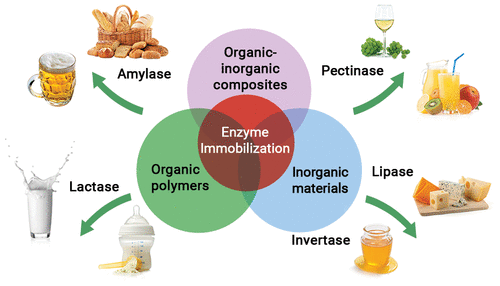Enzymes have for a long time been connected to the processes of food preparation before new technologies were created. But as the food industry continues to grow along with technology, how enzymes are used to improve taste, texture or the lifespan of food continues to grow as well.
Microorganisms that create enzymes such as fungi, bacteria, and yeast continue to improve and enhance the taste of food while creating economic benefits to communities and industries. Enzymes can be plant, animal, or microbial-derived, but the food industry heavily relies on microbial enzymes because they provide consistency in production and are cost-effective.
Food preparations and processes such as fermentation have long relied on microorganisms that create enzymes and these processes have been in existence for many generations. Microbial enzymes have taken a center stage in food production because of their stability when compared to animal or plant enzymes. The cost-effective fermentation techniques available means that they can be easily created while using less space and time. Easy process modifications and optimization and high consistency are essential and achievable through microbial enzymes.
The food industry uses enzymes in the production of crystalline glucose, maltose syrup, glucose syrup, and high fructose corn syrups. Enzymes are also used in the textile and paper industries. At American Biosystems we provide a variety of high-quality enzymes for different industries.
How Microbial Enzymes are used in the food industry
A-Amylases
These are starch degrading enzymes that are highly distributed in all organisms and are capable of hydrolyzing a-1,4 glycosidic bonds of polysaccharides. These enzymes are widely used in the food industry in the processes of baking, starch liquefaction, brewing, and as a digestive aid.
In the baking industry, they are used as flavor enhancers and antistaling agent to improve the quality of bread, stretch ad taste. It also can extend the freshness of the bread after baking.
For the production of powdery foods and rice cakes, high molecular mass branched dextrins are required and a-amylases are used to manufacture them.
To produce ethanol, a-amylases are used to convert the starch into fermentable sugars while further fermentation of the sugars to alcohol is done by Saccharomyces cerevisiae.
Glucoamylases
This is an exo-acting enzyme that catalyzes the hydrolysis of polysaccharide starch from a non-reducing end to release B glucose.
Glucoamylases are used in the production of high fructose syrups, and high glucose syrups, and in baking to reduce dough staling, improve flour quality and bread crust, and also the quality of high-fiber baked products. It’s also used in the production of soya sauce and light beer. For a light beer, Glucoamylases are used to metabolize dextrins and in turn, convert them to fermentable sugars with reduced calorific value and alcohol content.
Proteases
This enzyme is widely used in the food industry representing about 60% of use. The proteases catalyze the hydrolysis of peptide bonds that are present in polypeptides and proteins and are widely derived from animals, plants, and microorganisms. Plant-derived proteases such as papain, ficin, and bromelain are used for brewing, coagulation of milk, meat tenderizing, and as an aid for digestion. They are also used as an aid to improve the flavor, solubility, digestibility, and nutritional value of proteins in food. Baked foods, waffles, and bread production also rely on this enzyme for improved taste and shape.
To advance beer fermentation by balancing the amino acid profile, fungal protease is used. Cheesemakers use naturally occurring protease to accelerate the ripening of cheese, reduce allergenic properties, and modify the functional properties of milk products. And when making the cheese, the protease is used to hydrolyze peptide bonds to generate macropeptides and paracasein.
Lactase (B-Galactosidase)
Belonging to the hydrolases family, B-galactosidase is used to catalyze the hydrolysis of lactose. Sources of this enzyme include animals, plants, and microorganisms such as fungi, bacteria, and yeast. Due to higher yields, the microbial production of the protease is a common choice. To get reduced levels of lactose intolerance in milk and milk-based products, lactase is used. It is also used to enhance the creaminess and scoopability of ice creams. Hydrolyzing lactose into monomers also reduced the need to add sweeteners as they naturally improve the sweetness of products.
Lipases
Naturally present in human and animal bodies (stomach and pancreas) lipases aid in digesting fats and lipids. Hydrolysis of long-chain triglycerides is catalyzed by lipase enzymes. Fungi, yeast, and bacteria create microbial lipases, and these are used in fruit juice, beer, wine, dairy, and baking processes in the food industry.
They are used for developing flavors in dairy products and when processing fat-based foods. Cheese flavor can be improved by lipases as it acts on the fat in the milk during hydrolysis to produce free fatty acids. For cheese processes, different lipases are used and these in turn can equally improve the softness and texture of cheese.
In butter and margarine production, lipases are used as agents for flavor development. They can also be used to extend the shelf life of different baking products. To improve or modify wine aroma lipase is also used.
Phospholipases
This enzyme breaks down phospholipids into fatty acids and other lipophilic substances selectively. Based on their mechanism of action they are divided into four major cases (A, B, C, and D). Phospholipases are commonly used in oil production, dairy, and bakery processes but also in degumming vegetable oils and cheese and bread manufacturing.
In dairy processes, phospholipases are used to improve fat stability, and maximize cheese, milk, ice cream, or butter yield.
Esterases
Esterases facilitate the splitting of esters into alcohol and acid if used in an aqueous solution. They are used in oil and fat modification in a variety of fruit juices and are also used to produce flavors and fragrances.
